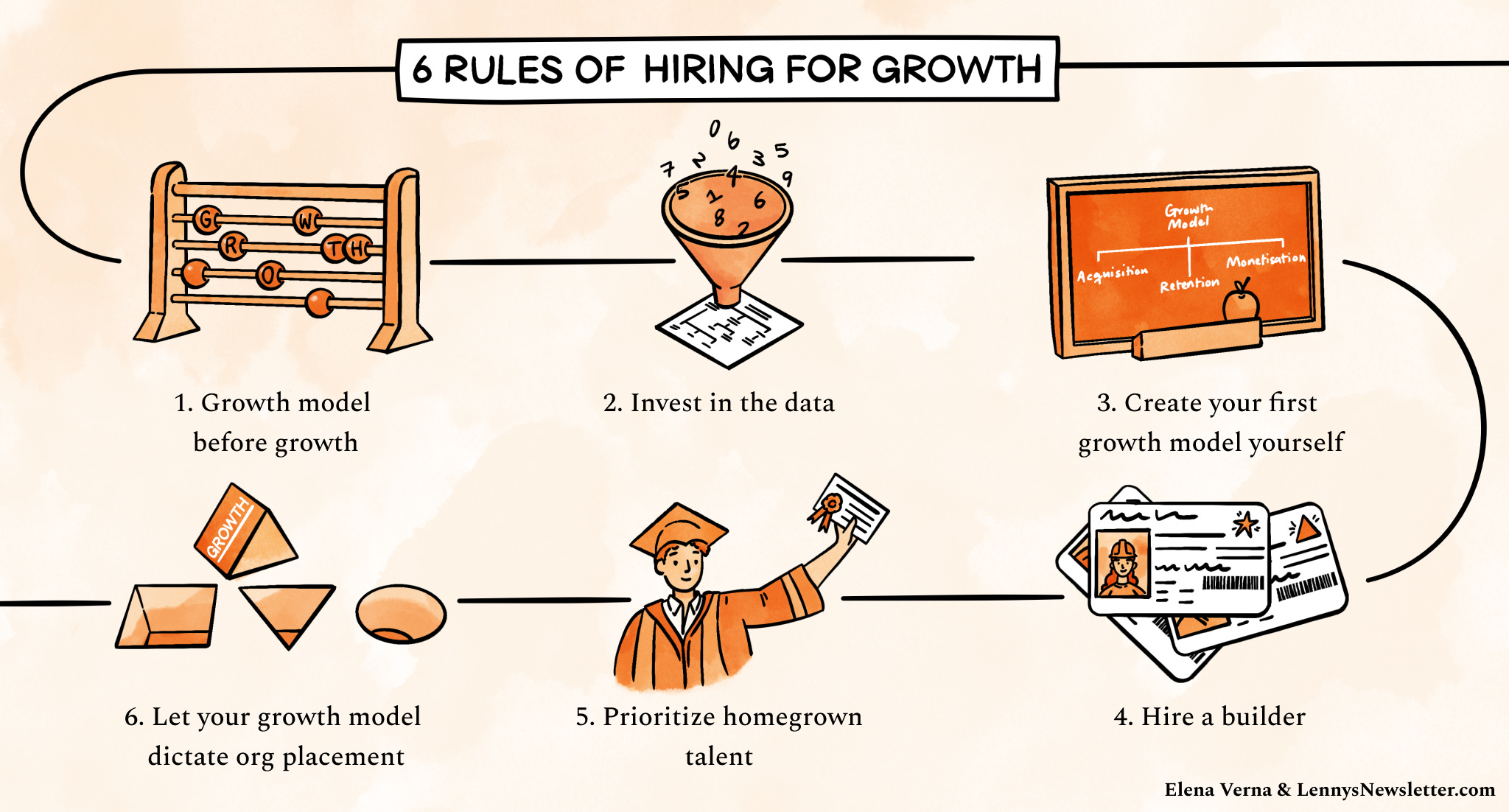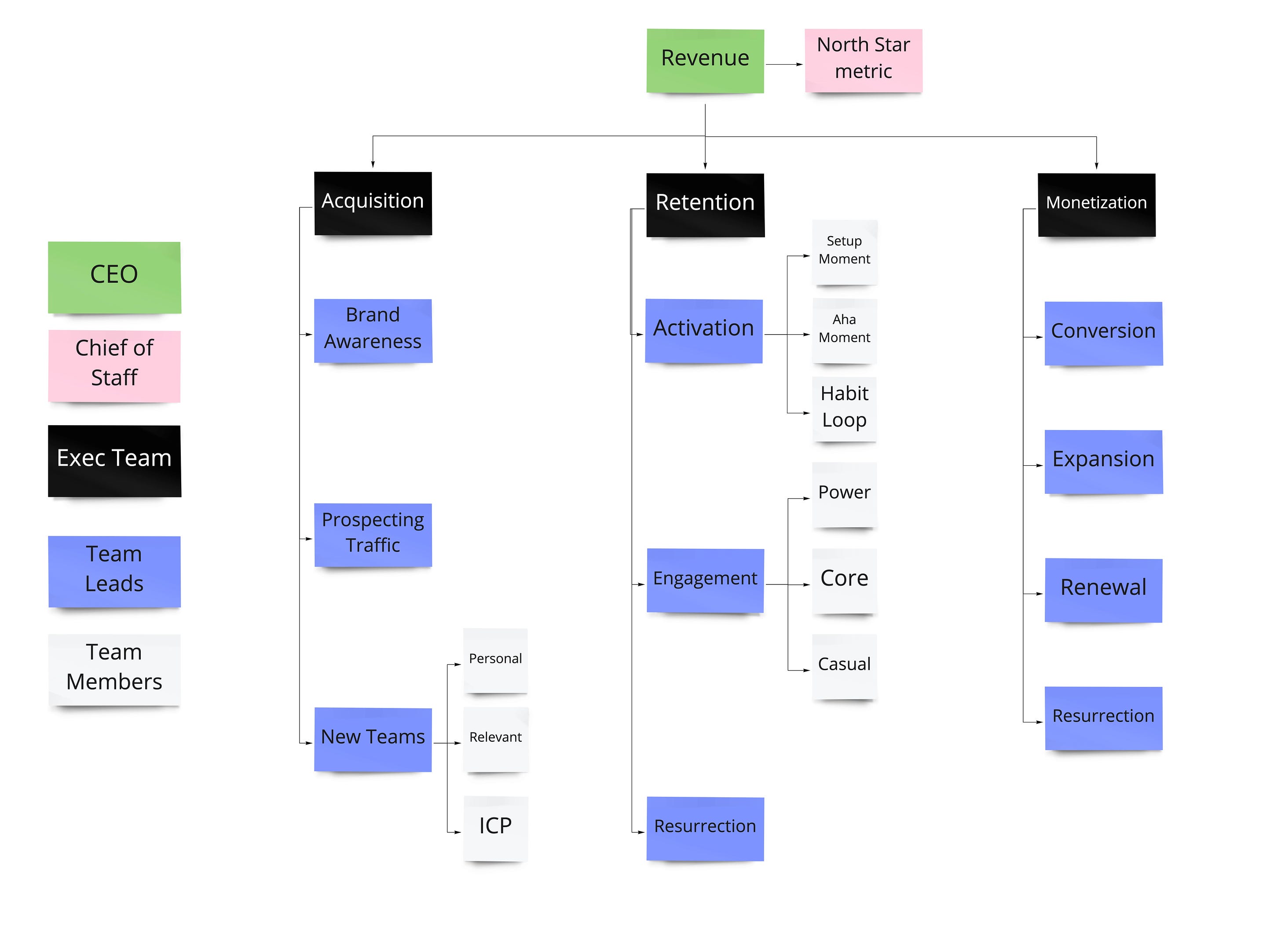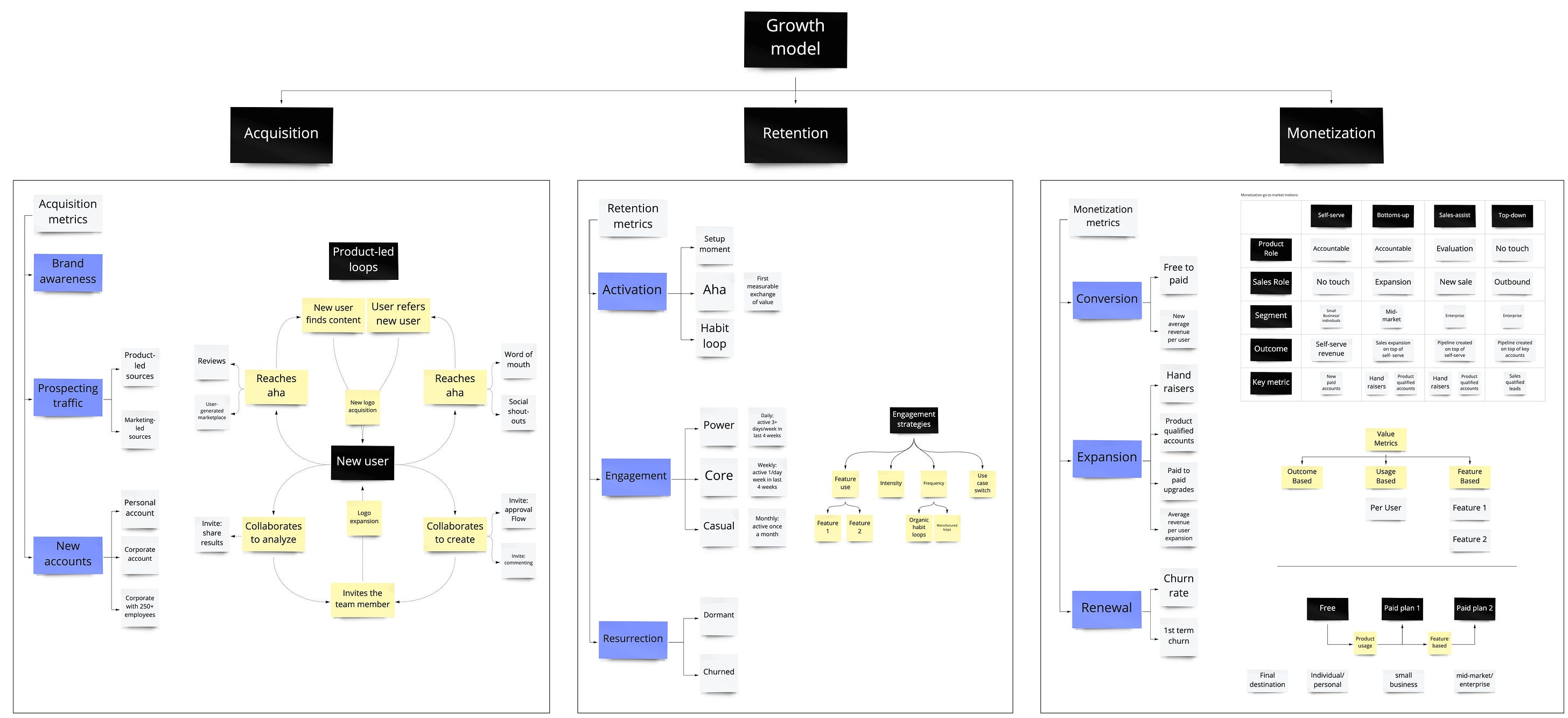Lenny's Newsletter - Six rules of hiring for growth
👋 Hey, Lenny here! Welcome to the monthly ✨ free edition ✨ of my weekly newsletter. If you’re not a subscriber, here’s what you missed this month:
As Paul Graham teaches us, “Startup = growth. The only essential thing is growth. Everything else we associate with startups follows from growth.” Thus, your first growth hire is one of the most important hires you’ll make. To tackle your question, I’ve pulled in Elena Verna, one of the smartest growth people I’ve ever met (and who I’ve been trying to convince to write a guest post for nearly a year). Below, Elena generously shares her six hard-won lessons on growth hiring. Over the past 10+ years, Elena has helped hire and build growth teams at companies like Netlify, MongoDB, HP, and Krisp, and previously led growth at Miro, SurveyMonkey, and Malwarebytes. An early draft of this post has already become my go-to reference for helping founders figure out their growth hiring strategy, and I’m excited to share it with you all. You can find Elena on LinkedIn and Twitter. Do you have strong product-market fit and feel ready to ramp up your investment in growth by hiring your first full-time growth person? Unfortunately, some of the first set of decisions that founders make when embarking on this journey are flawed. The most common mistakes they make are:
Today I want to offer a step-by-step framework for how to go about building a successful growth team. Rule 1: Growth model before growthGreat products have incredible product-market fit—they have correctly proved a compelling value hypothesis that describes why a customer is likely to use the product. Great companies, on the other hand, have product-market fit coupled with a strong growth model—predictable, sustainable, and defensible strategies that help achieve maximum distribution in the market. Just like a product, your growth model needs to be researched, built, launched, and iterated on. You won’t get it right immediately. I suggest spending time on this during, or shortly after, you’ve found product-market fit, to ensure that your initial traction can be scaled. A growth model is made up of two parts:
Growth levers describe ways to impact your business’s revenue growth by making changes to your customers’ journey. Growth levers answer the following questions:
Every growth lever is leveraged through a growth motion. A growth motion describes which team or tactic is accountable for a successful outcome in the growth lever. There are many fantastic, established growth motions to apply to each growth lever, such as product-led, sales/success-led, marketing-led, support-led, community-led, etc. Let’s explore the first three: 1. Product-ledProduct is accountable for the output of the growth lever by engaging customers in product actions.
2. Sales- and success-ledThe sales team engages customers in the actions that will result in the growth lever output.
3. Marketing-ledMarketing engages customers in the actions that will result in the growth lever output.
Now mix and match, layer, and sequence the above motions across the growth levers! You can be marketing-led in acquisition; product- and sales-led in monetization; and product-led in retention; while ideating how to sequence product-led to acquisition. The unique combination, layering, and sequencing of the growth motions localized for your product and deployed against your growth model is what will create a predictable, sustainable, and competitively defensible growth model. So what is your most critical growth lever right now and most likely growth motion to apply against it? Rule 2: Invest in the dataAlthough the final desired output of any business is revenue, the levers that a team pulls to impact revenue sit deep within the user journey of your product. Relying on financial performance as the ultimate guiding principle for decision-making leads to short-term revenue optimization and limited investment in long-term sustainable growth. Understanding customer progression through a data lens will help you identify not only which growth lever you should prioritize, but where you should focus your efforts to yield the biggest short- or long-term impact. Whether you are a marketplace, SaaS, direct-to-consumer, social network, or any other type of business, you can think of your data as a company organizational chart:
Building a company’s data organization will allow you to:
It may take many years to develop a comprehensive company data org, but once you do, you will be data-driven. Focus on the “leadership team” first, which will get you to a data-informed stage. Starting to identify team members will transition you to data-driven territory. See more on data efficacy stages in this blog post, and a guide to helping you find your North Star metric. Rule 3: Create the first growth model yourselfThis is where you do not hire the Head of Growth. It is up to the core leadership team to figure out the first version of your growth model—the primary levers and motions that you believe will drive your business growth. Only you know all the nuances of the market, product, and customer, hence are best positioned to put together the first version of a growth model that will have the highest likelihood of success. Your growth model, just like product-market fit, is part of the core foundation of your company. Product, marketing, and growth leaders can help you evolve and scale initial traction, evolving your business for long-term success. But doing the first growth-model exercise with the founding team will help you create an authentic growth model that closely leverages your product-market fit strengths and takes advantage of the market opportunities. In fact, companies leverage their growth models to win against direct competitors. Two examples:
So why is it a bad idea to outsource the first growth-model creation exercise to the Head of Growth?
It is important to understand that the initial growth model is a hypothesis with assumptions that are yet to be proven. Your team’s first order of business will be to learn about the validity of the assumptions. Here’s a sample template for what a growth model could look like: Rule 4: Hire a builderIn growth, there exist three types of profiles:
In almost all cases, you want to start by hiring a Builder, to prove your model’s validity. If most of your assumptions were right and you are enjoying early traction, you should move to Optimizers next to capture most of the value, finishing with Innovators to begin iterating on the model. If your growth model hypothesis was wrong and you are not seeing the expected impact, then move to Innovators next, who will help you evolve the model based on existing learnings from failures, going after Optimizers only after traction with the growth model has been established. Rule 5: Prioritize homegrown talentAs tempting as it is to open a new role for growth and hire from the outside, it is often the quickest way to fail in growth efforts. Reasons include:
Growth is about evolution, not revolution. Almost nobody starts their career in growth. Most successful growth leaders came from other departments. A few examples:
Among the unifying qualities across all of these growth leaders are their natural powers to:
So who are the people within the analytics, product, marketing, engineering, or even financial planning and analysis team to take on the first builder/innovator roles? Rule 6: Let your growth model dictate growth org placementShould the growth team be in marketing? Product? Sales? Community? Support? Although each organization and their leaders are unique and hence there is no universal right answer, your growth model should help inform the decision process. Step 1: Start by prioritizing the growth lever you need to drive the most improvement for:
Most companies start with acquisition or retention (specifically onboarding), followed by monetization. Step 2: Next, your growth model should indicate what growth motion you either need to build out, optimize, or introduce: marketing-led, product-led, sales-led, etc. For example, to build on the acquisition lever mentioned in Step 1:
Avoid hiring a growth marketer to solve your product-led motion. In addition to lacking the background to create the most value, they will spend much of their time spinning wheels outside their function in meetings with the product team because of the changes that person’s motions will require to the product. Lastly, companies often wonder whether they should embed growth within an existing team or create a stand-alone function. Most companies end up going through cycles of centralization and functional distribution of the growth teams because both models have their strengths and weaknesses. Embedded teams
Stand-alone teams
I would recommend always starting with the embedded model, to ensure that growth is an evolution and not a revolution, while frequently re-evaluating organizational design. Growth models and growth teams are just as important to a successful business as strong product-market fit. There are many incredible products that you’ve never even heard about because they have not invested in their growth model and end up slowly dying. Conversely, there are a lot of terrible products with such strong growth models that they make a company incredibly successful. In any case, I hope you use the tools I’ve described here to create a great growth team and build a successful company! 📚 Helpful additional resourcesThanks, Elena! You can find her on LinkedIn and Twitter. 🔥 Featured job openings
Browse more open roles, or add your own, at Lenny’s Job Board. How would you rate this week's newsletter? 🤔Legend • Great • Good • OK • Meh If you’re finding this newsletter valuable, consider sharing it with friends, or subscribing if you haven’t already. Sincerely, Lenny 👋 You’re a free subscriber to Lenny's Newsletter. For the full experience, become a paid subscriber. |
Older messages
🚨 Applications now open for my live course—Product Management Fundamentals
Friday, November 5, 2021
A three-week part-time live course with in-depth lectures, real-world assignments, special guests, and much more
Picking a wedge
Tuesday, October 26, 2021
When, why, and how to pick a wedge for your product
60 ideas to boost your growth
Tuesday, October 12, 2021
A motherload of growth inspiration by guest author Ali Abouelatta, creator of the First 1000 newsletter
The 10 commandments of salary negotiation
Friday, September 24, 2021
Guest post by Niya Dragova, co-founder of Candor
How to use behavioral science to boost your conversion rates
Friday, September 17, 2021
Guest post by Kristen Berman, co-founder of Irrational Labs
You Might Also Like
🚀 Ready to scale? Apply now for the TinySeed SaaS Accelerator
Friday, February 14, 2025
What could $120K+ in funding do for your business?
📂 How to find a technical cofounder
Friday, February 14, 2025
If you're a marketer looking to become a founder, this newsletter is for you. Starting a startup alone is hard. Very hard. Even as someone who learned to code, I still believe that the
AI Impact Curves
Friday, February 14, 2025
Tomasz Tunguz Venture Capitalist If you were forwarded this newsletter, and you'd like to receive it in the future, subscribe here. AI Impact Curves What is the impact of AI across different
15 Silicon Valley Startups Raised $302 Million - Week of February 10, 2025
Friday, February 14, 2025
💕 AI's Power Couple 💰 How Stablecoins Could Drive the Dollar 🚚 USPS Halts China Inbound Packages for 12 Hours 💲 No One Knows How to Price AI Tools 💰 Blackrock & G42 on Financing AI
The Rewrite and Hybrid Favoritism 🤫
Friday, February 14, 2025
Dogs, Yay. Humans, Nay͏ ͏ ͏ ͏ ͏ ͏ ͏ ͏ ͏ ͏ ͏ ͏ ͏ ͏ ͏ ͏ ͏ ͏ ͏ ͏ ͏ ͏ ͏ ͏ ͏ ͏ ͏ ͏ ͏ ͏ ͏ ͏ ͏ ͏ ͏ ͏ ͏ ͏ ͏ ͏ ͏ ͏ ͏ ͏ ͏ ͏ ͏ ͏ ͏ ͏ ͏ ͏ ͏ ͏ ͏ ͏ ͏ ͏ ͏ ͏
🦄 AI product creation marketplace
Friday, February 14, 2025
Arcade is an AI-powered platform and marketplace that lets you design and create custom products, like jewelry.
Crazy week
Friday, February 14, 2025
Crazy week. ͏ ͏ ͏ ͏ ͏ ͏ ͏ ͏ ͏ ͏ ͏ ͏ ͏ ͏ ͏ ͏ ͏ ͏ ͏ ͏ ͏ ͏ ͏ ͏ ͏ ͏ ͏ ͏ ͏ ͏ ͏ ͏ ͏ ͏ ͏ ͏ ͏ ͏ ͏ ͏ ͏ ͏ ͏ ͏ ͏ ͏ ͏ ͏ ͏ ͏ ͏ ͏ ͏ ͏ ͏ ͏ ͏ ͏ ͏ ͏ ͏ ͏ ͏ ͏ ͏ ͏ ͏ ͏ ͏ ͏ ͏ ͏ ͏ ͏ ͏ ͏ ͏ ͏ ͏ ͏ ͏ ͏ ͏ ͏ ͏ ͏ ͏ ͏ ͏ ͏ ͏ ͏ ͏ ͏ ͏
join me: 6 trends shaping the AI landscape in 2025
Friday, February 14, 2025
this is tomorrow Hi there, Isabelle here, Senior Editor & Analyst at CB Insights. Tomorrow, I'll be breaking down the biggest shifts in AI – from the M&A surge to the deals fueling the
Six Startups to Watch
Friday, February 14, 2025
AI wrappers, DNA sequencing, fintech super-apps, and more. ͏ ͏ ͏ ͏ ͏ ͏ ͏ ͏ ͏ ͏ ͏ ͏ ͏ ͏ ͏ ͏ ͏ ͏ ͏ ͏ ͏ ͏ ͏ ͏ ͏ ͏ ͏ ͏ ͏ ͏ ͏ ͏ ͏ ͏ ͏ ͏ ͏ ͏ ͏ ͏ ͏ ͏ ͏ ͏ ͏ ͏ ͏ ͏ ͏ ͏ ͏ ͏ ͏ ͏ ͏ ͏ ͏ ͏ ͏ ͏ ͏ ͏ ͏ ͏ ͏ ͏ ͏ ͏ ͏ ͏ ͏
How Will AI-Native Games Work? Well, Now We Know.
Friday, February 14, 2025
A Deep Dive Into Simcluster ͏ ͏ ͏ ͏ ͏ ͏ ͏ ͏ ͏ ͏ ͏ ͏ ͏ ͏ ͏ ͏ ͏ ͏ ͏ ͏ ͏ ͏ ͏ ͏ ͏ ͏ ͏ ͏ ͏ ͏ ͏ ͏ ͏ ͏ ͏ ͏ ͏ ͏ ͏ ͏ ͏ ͏ ͏ ͏ ͏ ͏ ͏ ͏ ͏ ͏ ͏ ͏ ͏ ͏ ͏ ͏ ͏ ͏ ͏ ͏ ͏ ͏ ͏ ͏ ͏ ͏ ͏ ͏ ͏ ͏ ͏ ͏ ͏ ͏ ͏ ͏ ͏ ͏ ͏ ͏ ͏ ͏ ͏ ͏ ͏ ͏ ͏





